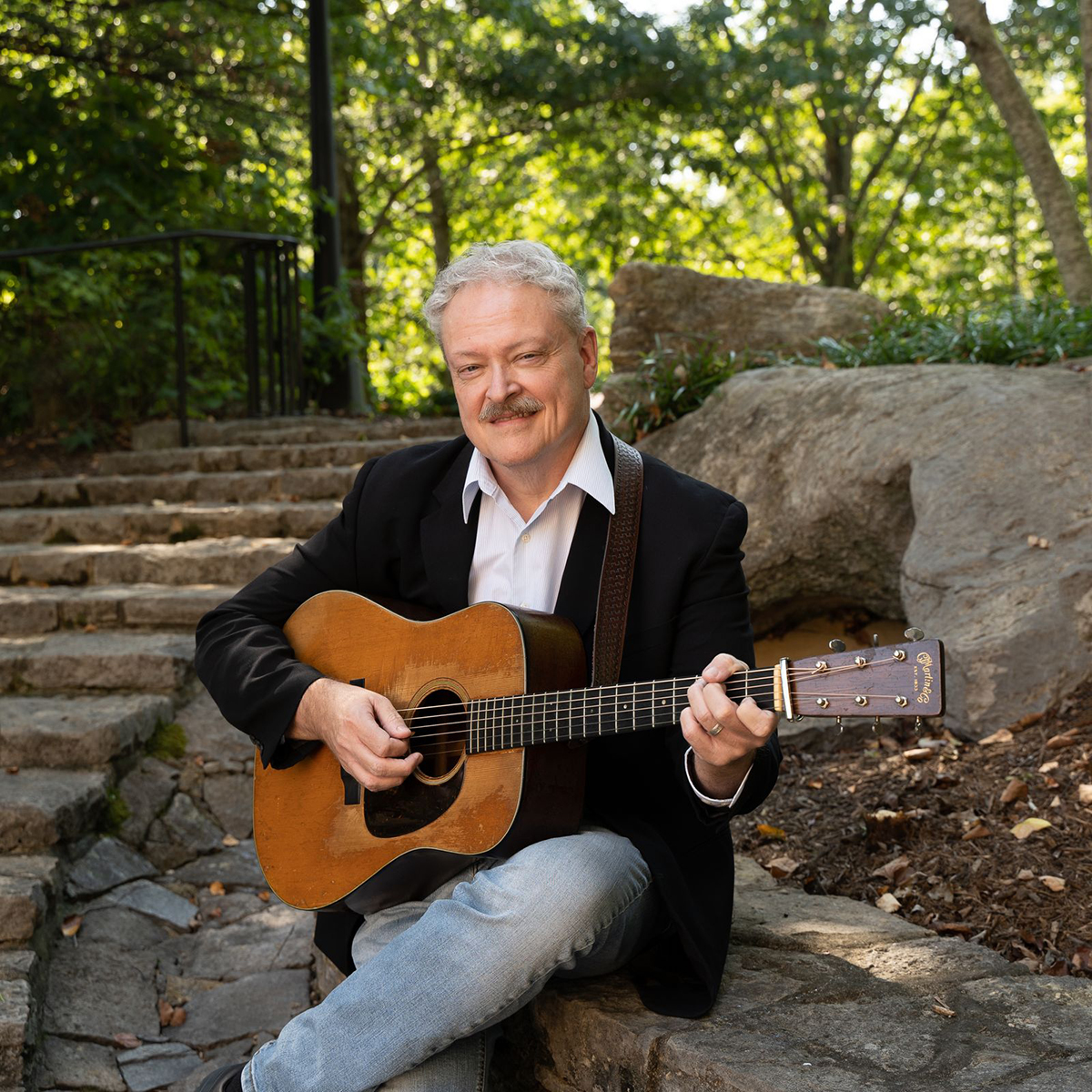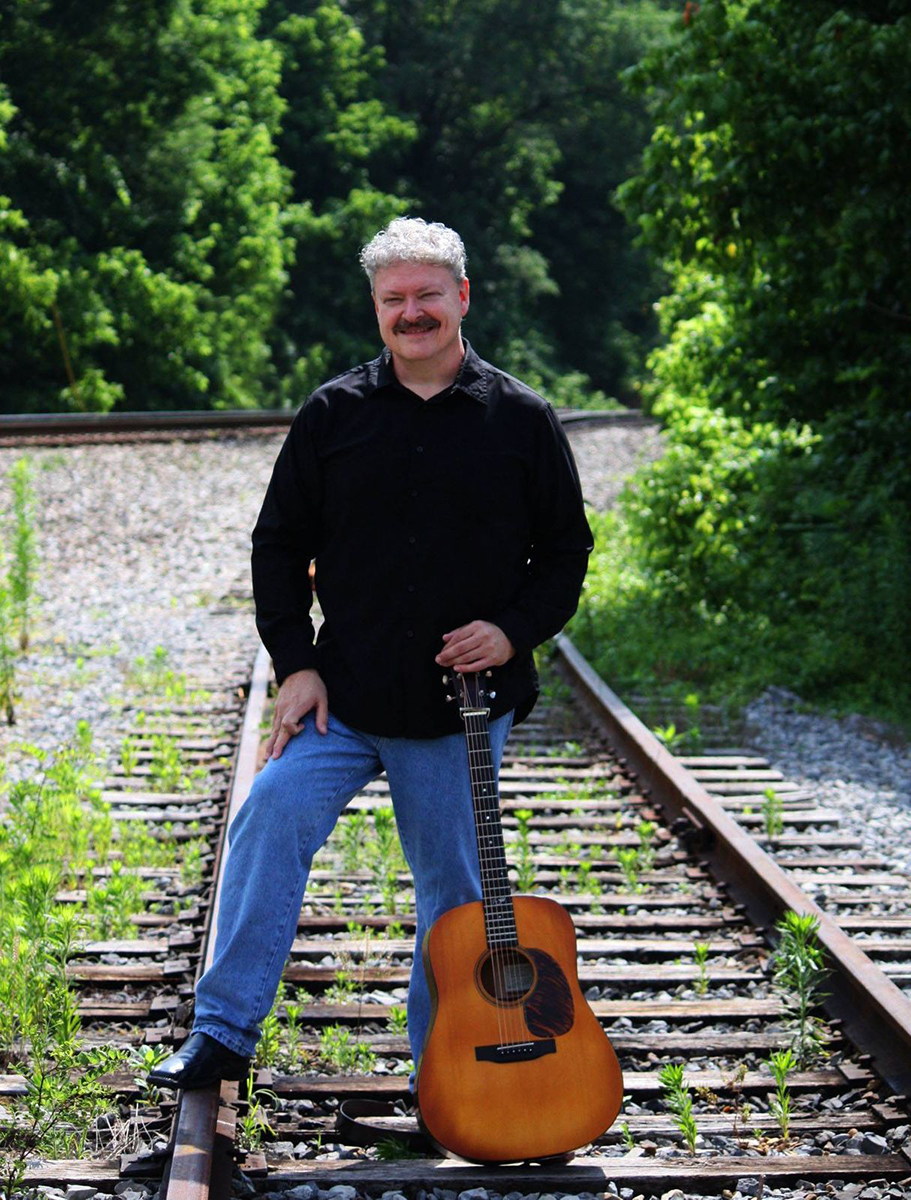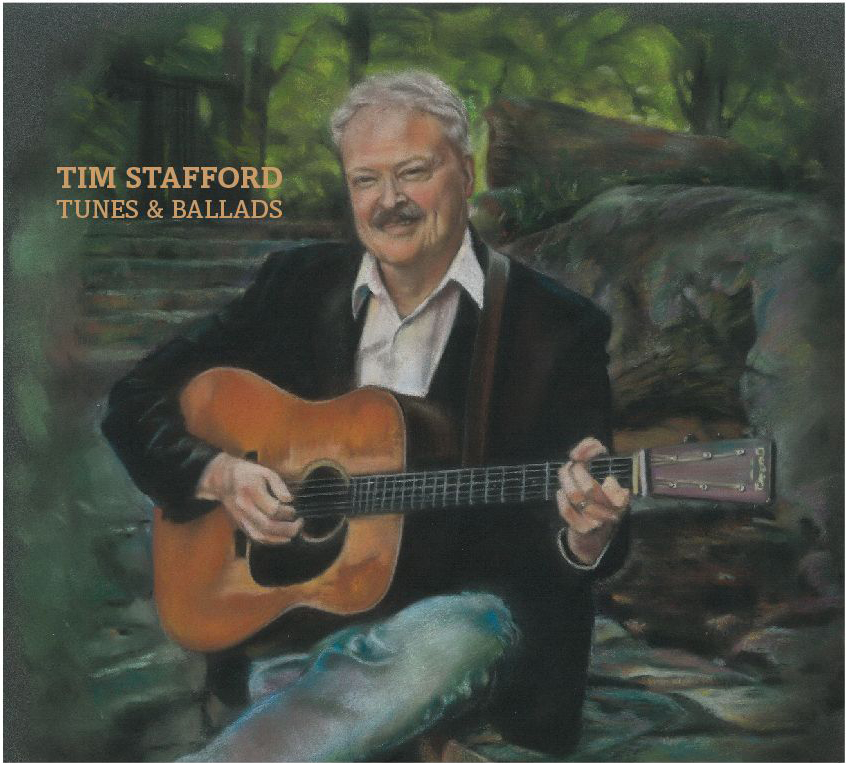20:20 — 20 questions, 20 answers
Published January 22, 2021
In part 18 of our series,
the incredibly prolific Tim Stafford —who has written right at 100 songs just during the pandemic—
is our guest this week.
A remarkably accomplished artist and Tony Rice co-biographer, Tim is also a founding and current member of Blue Highway and former member of Alison Krauss & Union Station. A Grammy, Dove, IBMA, and SPBGMA awards winner, Tim recently released his fourth solo record Tunes & Ballads. Join us as Tim shares openly about writing, creating, his love of history, nostalgias, and so much more.
~NWM

Photo by Ben Bateson | Photos courtesy of Tim Stafford
20:20 with Tim Stafford
NWM 1): Please introduce yourself, briefly, as a musician and human of Earth.
Tim: I’m Tim Stafford, 60 years old, born in Kingsport, Tennessee, still live on Earth in the East Tennessee area with my wife, Janet. My sisters played piano and introduced me unwittingly to the Beatles and 60s pop. Got involved in bluegrass in the mid-70s in high school and have been in it ever since. First professional gig was with Alison Krauss & Union Station in 1990. I consider myself a songwriter and guitarist first.
NWM 2): What is a favorite of your songs? Please tell us a little bit about it.
Tim: Hard to pick one. I still have a lot of people ask me about ‘Midwestern Town,’ which I wrote in the mid-90s and Ronnie Bowman recorded on his The Man I’m Trying to Be for Sugar Hill (1998). It came to me all at once—only one that’s ever happened that way—as I was playing with my son at my home in Kingsport, Tennessee.
I overheard a TV in another room where Nanci Griffith was singing a song that held a note through three or four chord changes. I immediately went to the other room with my guitar and the whole thing just spilled out, lyrics and all. It’s completely fictional too, but people have come to me in tears saying they knew who it was written about, or that they identified with it in some way. I think it helps when you can get a singer as great as Ronnie to record it.
The creative process is addictive, especially in songwriting.
NWM 3): Name three things that make you smile.
Tim: 1) Nostalgias, or intense memories that bring back good feelings—some rather obscure and mysterious. This is something I’ve thought a lot about, to the point that I have a list of them that keeps expanding. I can almost feel endorphins being released when I think of one of these things—not sure if anyone else has ever had this experience or not. 2) Family and friends. 3) Intensely good music and movies, which I usually go see with my son, Daniel, and sometimes with my wife, Janet.
NWM 4): You are an accomplished artist, Grammy, Dove, IBMA, and SPBGMA awards winner, former member of Alison Krauss & Union Station, founding member of Blue Highway, and much more. What has been a particularly rewarding experience of your career so far?
Tim: Just being able to do it for a living and being able to create. The creative process is addictive, especially in songwriting.
NWM 5): Your latest solo album Tunes & Ballads contains several songs with historical subjects—the Wild West Show, Jack the Ripper, the Titanic, and the USS Arizona. Please share some about your interest in history and spinning history into music.
Tim: I’ve always loved history—my undergrad co-major. I got a master’s in it, and worked on a PhD. And, I’ve always loved the American West, and still really do.
The show was a visualization of an idea of something that was disappearing in real life, and I think it’s so interesting, the intersection of history, entertainment, and drama.
Just finished Desert Solitaire [a book by Edward Abbey] last year. There’s something about real characters from the West that all of us know about, and who these real people were, that’s always fascinated me. That’s why I keep writing songs about people like Billy the Kid, Wild Bill Hickok, Doc Holliday, and Buffalo Bill Cody and his Wild West Show. The show was a visualization of an idea of something that was disappearing in real life, and I think it’s so interesting, the intersection of history, entertainment, and drama.
The Titanic and Arizona fascinated me probably because my Dad was a Navy man in World War II, but I wasn’t inspired to write anything about the Arizona until I went to see the Memorial and was told the story about the ‘Arizona Tears.’

Photo by Kim Miller
NWM 6): If you could see anyone from throughout history perform who would it be?
Tim: Wow, tough one. Probably the Beatles. I saw McCartney at the Grammys, and that’s close, but … Followed, closely, by the original bluegrass band: the Blue Grass Boys 1945-48 with Bill Monroe, Lester Flatt, Earl Scruggs, Chubby Wise, and Howard Watts. Also, Jimmie Rodgers, Emmitt Miller, Robert Johnson, Arnold Schultz.
NWM 7): Who might we be surprised to find on your playlist?
Tim: Blues, classical music, jazz, and soundtracks. When I was a kid, I loved show tunes and soundtracks—still do. That music can be incredibly moving to me, and sometimes I just don’t know why.
NWM 8): You have taught not just music, but subjects ranging from American History to Mass Communications and Popular Culture at colleges and universities. You have also been a teacher at practically every bluegrass-oriented camp, such as Rockygrass Academy. Please share a bit about this part of your life and what teaching means to you.
Tim: I do enjoy teaching when I get the chance under the right circumstances.
Some of the most important things I learned from my teachers was their attitude—their way of looking at the world.
There’s something about that ‘Aha’ moment that students get that just brings a smile to any teacher’s face, but it’s also a way to pass things on to others. Some of the most important things I learned from my teachers was their attitude—their way of looking at the world.
NWM 9): What are your special interests beyond music?
Tim: I love to read, walk, write, eat (love that too much, lol). For some reason, I’ve always had the ability to imitate people’s voices, ever since I was young. I’ve co-written one book and am working on another one, and I do enjoy scholarship about bluegrass and vernacular music—I collect books about the topic.

Photo by Kim Miller
NWM 10): Strangest road story?
Tim: Strange? Hmm. Once with AKUS, we started out in Toronto, played in Maine, flew to California, then back to Boston and then New York somehow without sleeping. When we checked into the Hotel Roosevelt (which closed after 100 years of business this year), the whole band slept for over 24 hours straight!
Another time with that band, we spent a week in the Hollywood Roosevelt (what was it with the Roosevelts?), where the first Oscars were held in the 1920s—Grauman’s Chinese Theater with all the handprints in the concrete was across the street. Adam Steffey and I ordered out at the Pink Dot every night. Then we made a music video for ‘Steel Rails’ at a western film set outside of town that I remembered from movies I had seen in the 1960s. It was surreal.
We made a music video for ‘Steel Rails’ at a western film set outside of town that I remembered from movies I had seen in the 1960s. It was surreal.
Once when Blue Highway went to New York City to appear on Sirius XM’s bluegrass show with Joey Black, I was trying to find a place to park our 15-passenger van. Al Roker of the Today Show crossed the street, and I yelled out at him ‘Hey Al!’ He came over to the van and I said, ‘Where can a man park a van around here?’ He looked befuddled and pointed somewhere. I thanked him and he walked off.
NWM 11): In March 2016, Blue Highway was named the most popular bluegrass artist in history in an online poll by Bluegrass Today. In your opinion, what makes Blue Highway so special?
Tim: Lol. I don’t know about that poll—wasn’t exactly scientific, but … The band still has four of the original members, and for 20 years we had the original five, so there was an element of continuity there, and our identity was tightly bound up in our songwriting—still is. I love that about the group, and that we seem to have similar ways of thinking about material, music, and those things. We’ve laughed our heads off over the years.
NWM 12): You have worked with more than 75 different artists, including Willie Nelson, Kenny Chesney, Charles Sawtelle, and Tammy Rogers, just to name a few. What stands out as a memorable performance or recording session?
Tim: I didn’t meet Willie on the song I played for his session. Buddy Cannon called to see if I could add something to this cut, and I gladly drove to Nashville for it. Kenny [Chesney] was just a young kid at East Tennessee State University who wanted to do a record and asked me to produce his first one—I got Barry Bales to play bass and electric guitar, and Kenny and I played acoustic.
I got to record with Tony Rice, Sam Bush, Béla Fleck, Tony Trischka, and a few other heroes over the years …
There have been lots of memorable sessions. I got to record with Tony Rice, Sam Bush, Béla Fleck, Tony Trischka, and a few other heroes over the years and that was always special. One of the very first recording sessions I ever did was with Benny Sims, who had recorded so many classic songs with Flatt & Scruggs during their Mercury years, including ‘Foggy Mountain Breakdown,’ ‘Roll in My Sweet Baby’s Arms’ and so many more. The initial recording sessions for Every Time You Say Goodbye with Alison were fun, and we knew it was going to be a good record. All of the Blue Highway records have been special in their own way.
One of the first records I did with musicians outside my area was Butch Baldassari’s Old Town, which was the first time I’d recorded with Alison, Tom Adams, Stuart Duncan, Mike Bub, and others. Another time I did an entire record with Jorma Kaukonen, the Rock & Roll Hall of Famer from Jefferson Airplane—quite a trip and he’s a very cool guy. Way too many to focus on much.
NWM 13): Apart from live music, what are you most looking forward to when things return to ‘normal?’
Tim: Going to the grocery store without worrying about catching a potentially fatal disease.
Going to the grocery store without worrying about catching a potentially fatal disease.
NWM 14): What song/album could you play on repeat?
Tim: Definitely J.D. Crowe & the New South, ‘Rounder 0044’ with Crowe, Tony Rice, Ricky Skaggs, Jerry Douglas, and Bobby Slone (1975). High-water mark of Bluegrass, in my opinion.

Photo by Jessica Boggs
NWM 15): You are a prolific songwriter, having recorded more than 250 songs. What in particular fuels your inspiration? Tell us about your space or what is most necessary for your writing.
Tim: It’s probably way more than that. During the pandemic, I’ve written right at 100 songs, most of them co-written via Zoom. I travel over to my buddy Bobby Starnes’ house about 15 minutes away to write with him still.
During the pandemic, I’ve written right at 100 songs …
I lost one of my best friends and co-writers, Steve Gulley, last year to cancer—still trying to process that. Been writing once a week with Thomm Jutz and regularly with Rick Lang, Bill Whyte, Mark Bumgarner, Eric Gibson, Wood Newton, Terry Herd, Jon Weisberger, Joe Newberry, Becky Buller, Bob Minner, and others. Thomm and I are going to be putting a record out soon of our songs, which are very different for me, some really good stuff.
NWM 16): We’re very curious about writing music for lyrics vs. writing instrumental music. Do you see a story unfolding even in those songs without words? Please elaborate on the inherent differences between these and your approach to them.
Tim: Good question. I tend to think of them as separate things, although the melody has to carry a song in my opinion. The best lyrics in the world won’t help a bad melody. Guitar-specific instrumentals for me, either flatpicked or fingerpicked, have their own dynamic unique to the instrument. That’s pretty distinct from melodies that I hear at times and immediately need to record. Occasionally they come back out years later in the service of a set of lyrics that seems like a good match. Sometimes the melody will definitely invoke a story without words—if you can use those, they make the best songs.

Cover art by Tuesdee Zoldy
NWM 17): On your new album, Tunes & Ballads, among our favorites are the instrumental tracks. They are soulful and atmospheric, particularly ‘Galapagos’ and ‘Pale Blue Dot.’
Location is a continuing theme, with ‘Beech Creek’ and ‘Shenandoah Valley Blues.’ Please share a bit about this, the importance of these particular locales or location as a theme in general within this beautiful music you have created.
Tim: Thank you. I wrote the DADGAD [a tuning method] tune ‘Galapagos’ nearly 35 years ago in the mid-80s when I was living in Norton, Virginia. Just seemed to come together at a time when I was listening to a lot of classical music, although it isn’t based on anything in particular.
‘Pale Blue Dot’ (out of Bm position in standard tuning) had that aching sort of sadness that appeals to me. It reminded me of the photo of Earth taken by Voyager as it neared the outer solar system that Carl Sagan mentioned in his book Cosmos. From that immense distance, the Earth and everything we had ever hoped, feared, or thought of and everyone who had ever lived and died was contained in one tiny speck. The thought should bring us all together at times when we are concentrated on petty differences.
Place and sense of place is important to me … A beautiful view gets me every time.
Yes, place and sense of place is important to me—I’ve mentioned the West and its atmospheric scenery and landscapes. Places invoke memories and nostalgias (again), some that involve things that never happened personally to me somehow. I don’t know why I love the Shenandoah Valley other than its physical beauty, but I sure do. A beautiful view gets me every time.
NWM 18): ‘Sunny’ is another favorite from Tunes & Ballads. This tune seems just nearly perfect, at once expressive and profound. Please tell us about this particular song.
Tim: ‘Sunny’ was a jazz soul song written by Bobby Hebb and made popular by him in 1963. I sure remember hearing the original as a kid—there were countless covers, and it’s been used in commercials and movies. In bluegrass, Doyle Lawson put a version of it on his instrumental record Tennessee Dream on County Records in 1977. I wanted to record a guitar version that did homage to the original (with the same modulation), but also expressed my feeling about this exquisite melody.
NWM 19): What is one thing you would want our readers to know about you which we might not know to ask?
Tim: I love the book and especially the movie Lonesome Dove. Bobby Starnes and I will quote lines from it in normal conversation.
NWM 20): What’s next for Tim Stafford?
Tim: I hope to keep on writing songs as much as I can with my co-writers and hopefully more alone. Steve Gulley and I finished a record, Still Here, that will be coming out on the Mountain Home label in March 2021. There have been two singles released from it already, and although it will be bittersweet, Steve and I were both very excited about the songs. Thomm Jutz and I will be working on our duet record hopefully this year, and I’m hoping Blue Highway will be getting back to playing and maybe recording next year.
Tony’s passing on Christmas day 2020 is still something I’m trying to come to grips with, as is everyone in the bluegrass community.
I’m also working on a book about bluegrass music that’s intended to be a follow-up to Neil Rosenberg’s [Bluegrass: A] History of the genre that initially appeared in 1985, hopefully taking everything up to the present. I just wrote liner notes for Rebel Records’ reissue of Tony Rice’s California Autumn and will be writing notes for Craft’s boxed set of Tony’s work that’s set to come out this year as well.
Tony’s passing on Christmas day 2020 is still something I’m trying to come to grips with, as is everyone in the bluegrass community.
Galapagos

Tim Stafford
Tim Stafford was born and raised in Kingsport, Tennessee. His mother’s Browder side of the family is musical, and his twin sisters play piano and sing. After starting out on drums, Tim discovered bluegrass in the mid-1970s as a freshman at Ketron High School and became a banjo player. He switched to guitar in the late 70s and became a member of several groups, before co-founding Blue Highway in 1994. The band is one of the most decorated and influential in bluegrass history, having been nominated for 3 Grammys, winning a Dove Award, and nearly 30 IBMA Awards. In March 2016, Blue Highway was named the most popular bluegrass artist in history in an online poll by Bluegrass Today.
Tim released his first solo record, Endless Line in 2004 on FGM Records to critical acclaim. It was nominated for IBMA’s Instrumental Recording of the Year in 2005. His second, Just to Hear the Whistle Blow, was released in July 2014; his third, Acoustic Guitar, in September 2017. His fourth solo record, Tunes & Ballads, was released December 14, 2020.
To learn more and buy stuff, visit https://www.timstaffordguitar.com/home
You may enjoy our previous 20:20 with Thomm Jutz.
This is our art. Please consider leaving a tip. If not, that's okay too! Enjoy and share.
We thank our sponsors for their support! Check them out!
Experience world-famous live entertainment, thrilling attractions, outdoor adventure, delicious food, and genuine Ozarks hospitality. In Branson, precious moments with your family become memories that last a lifetime. No matter what your crew enjoys doing, Branson offers activities and natural wonders that will transform your visit into an unforgettable experience. Start planning your trip at www.ExploreBranson.com
The Acoustic Shoppe in Springfield, Missouri, serves musicians and students around the world, through online and in-person sales and instruction. Their teaching studio, The Academy, is a state-of-the-art music learning program that allows students to learn at their own pace with top teachers. The shop carries high-quality instruments at every price-point, all expertly set up and ready for you to play.
The Royal is an intimate space for music, refined bar food, upscale dive-bar drinks, and non-alcoholic options. We focus on music—live performances, vinyl, and curated playlists—60's Brit-pop, new wave classics, or Latin/world music. We specialize in listening room shows. Artists pour their life into their craft and deserve our attention. Swing by for a cocktail, snack, and conversation about music.
NoteWorthy Music is a music journal and salon platform supporting the music industry and giving voice to a growing chorus of diverse artists. We are transgenre, embracing art without labels. We celebrate art and artists by honoring the genuine creation and spirit of all who create and by receiving all art with respect and kindness—and without prejudice.
The views and opinions expressed by our guests are theirs and do not necessarily reflect nor represent the views and opinions of NoteWorthy Music or its staff.
Layout and Design by Bambi Grinder




